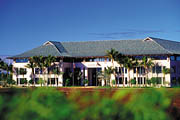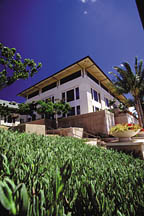

"Kapolei, designated Oahu's second city after Honolulu, had to be
able to provide the functional needs immediately required for the region, its future needs, and the need for public space," said Kurt Mitchell, AIA of Kober/Hanssen/Mitchell Architects in Honolulu, HI. "The city and county of Honolulu wanted this to be the finest building in Kapolei, to show the city's commitment to the second city, Kapolei."
The decision of the architects to use natural stone for the project was as deliberate as the selection of the limestone. "Stone was selected because of its ability to bring formality, naturalness, the aesthetics of strength and stability to the project's design," said Mitchell. "Generally, stone as a material represents a strong foundation for a building design, symbolic of the civic presence representative of a city building."
"The stone material picked was to reflect the natural color of the land, which is complemented by the stone's texture and color," he added. "In addition, as the building ages, and as the facade weathers, there will be a timeless distinctive characteristic only found in the way this stone ages."
Walker Zanger chose the limestone to come from Dimpomar in Vila Vicosa, Portugal, due to the nature of its quarry.
"Mocha Cream limestone from Portugal was selected because of the large quarry resources and its consistent nature within each block," said Mike Brunetti of Walker Zanger. "This allowed us to produce an order of this size and keep the stone consistent throughout the project."
Waldek Rojek, an installer with Draftstone Inc. of Honolulu, HI, accompanied Brunetti twice to Portugal to view the quarry and the production factory of Dimpomar, who quarried and fabricated the limestone.
"Dimpomar was chosen as the fabricator because of its long history of producing materials for special projects," said Rojek. "They had also just purchased a state-of-the-art three-dimensional carving machine which produced large Herringbone panels."
The Kapolei Civic Center required 31,000 linear feet of raw material. All of the limestone supplied was honed and in the form of wall panels of different thickness. The sizes ranged from 2-inch-thick case moldings to 14-inch-thick balcony rail caps. Two stories of interior cladding, three stories of exterior cladding and several herringbone columns and carved "Tiki" panels utilized the limestone, according to Brunetti.
"Like all large cut-to-size projects, there were many challenges coordinating the stone supply to the required schedule," said Brunetti. "Waldek Rojek of Draftstone was very helpful in this process by giving Walker Zanger the required schedule as soon as he had it. We were able to set a fabrication and shipping schedule from his installation schedule so he would have what he needed for each elevation he installed."
Rojek agreed that there were some challenges with the stone. For installation purposes, the stone panels were large and weighty. "Many of the pieces were huge in size and very heavy," Rojek said. "But our supervisors, equipment and experience helped us through the process, and it was a success."
To install the stone on the exterior, Draftstone Inc. used a mechanical, stainless steel light-gauge styled secondary support system, and fastened the panels in place with stainless steel clips. The secondary support system was made of light-gauge metal studs.
"Our installation for the interior was similar to the exterior," said Rojek. "Like typical Hawaiian-style buildings, there were a lot of open areas, with columns. So we treated it the same way we did the exterior."
The installation took a crew of 16 to 20 people about six months to complete.
"The project was delivered on time and Draftstone did a beautiful job with the installation," said Brunetti. "The project has been completed for two years now, and we have heard nothing but great things about the limestone and how it has held up in the ever changing Hawaiian weather."
Along with its enduring aesthetic qualities thus far, the Kapolei Civic Center has also been commended for its functionality. "The project as a building design has been well received," said Mitchell. "The project has achieved its design goals, is a multiple award winner, and most of all, has been accepted by the public for its role as a civic building."